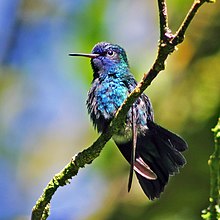| Blue-headed Hummingbird | |
|---|---|

| |
| Blue-headed hummingbird in Morne Diablotins National Park, Dominica | |
| Scientific classification | |
| Kingdom: | |
| Phylum: | |
| Class: | |
| Order: | |
| Family: | |
| Genus: | Cyanophaia L. Reichenbach, 1854
|
| Species: | C. bicolor
|
| Binomial name | |
| Cyanophaia bicolor (Gmelin, 1788)
| |
The Blue-headed Hummingbird (Cyanophaia bicolor) is a species of hummingbird in the Trochilidae family.
It is found only in Dominica and Martinique.
Its natural habitats are subtropical or tropical moist lowland forests and heavily degraded former forest.
The Blue-headed Hummingbird is classified in the Kingdom Anamalia, Phylum Chordata, Class Aves, Order Apodiformes, and Family Trochilidae. [2]
Characteristics edit
Due to the Blue-Headed Hummingbird’s deep blue head in contrast with its lighter blue breast and abdomen it is given the species name of bicolor. [3] The average Blue-Headed Hummingbird weight about 4.55 grams. [4] A male Blue-Headed Hummingbird has very distinct features. They have a long, blue, forked tail, a green head, and a blue body. [5] On average, they are about 9.5 cm big (3.75 in). The female Blue-Headed Hummingbird has a grayish-white stomach, with a green head and back. The female Blue-Headed Hummingbird is often said to be similar to the female Antillean Crested Hummingbird (Orthorhyncus Cristatus), but differs in that it has a longer bill and a longer tail. The female’s tails are blue with white corners. [6]
Habitat and Diet edit
The Blue-Headed Hummingbird is commonly found in trees eating insects in the canopy, or foraging for nectar at flowers. Nectar is the hummingbird’s main diet. [5]
The habitats for these birds are areas of higher elevation in wet forests and borders. They are commonly found in what is referred to as the secondary rainforest, which surrounds the primary rainforest. [3] The nests that the Blue-Headed Hummingbirds build are fairly low, and commonly only built up to eight feet high. [6]
Classifications edit
Researchers describe this species is describe as fairly common with an increasing population trend although the population size has not been officially quantified. [2]
The species has a very small range, having been found in only Dominica and Martinique, but it is still not believed to be approaching the thresholds of vulnerability. Because it is not within the vulnerable threshold, researchers evaluate it as an “Animal of Least Concern.” [7]
Although the species is classified as least concern, the future population trend is predicted to decline throughout the years due to construction and ongoing habitat destruction in the areas where the Blue-Headed Hummingbird exists. [7]
References edit
- ^ "Cyanophaia bicolor". IUCN Red List of Threatened Species. 2012.1. 2012. 2012.
{{cite journal}}:|access-date=requires|url=(help); Unknown parameter|assessors=ignored (help) - ^ a b BirdLife International 2012. Cyanophaia bicolor. In: IUCN 2013. IUCN Red List of Threatened Species. Version 2013.1. Web. 31 October 2013. <www.iucnredlist.org>.
- ^ a b Comings, David. "Blue-headed Hummingbird." Comings Birds. n.d. Web. 31 October 2013. <www.comingsbirds.com>.
- ^ “Blue-headed Hummingbird.” Wildlife Rehabber. n.d. Web. 31 October 2013. <http://wildliferehabber.com>.
- ^ a b "Cyanophaia Bicolor." Neotropical Birds. n.d. Web. 31 October 2013. <http://neotropical.birds.cornell.edu>.
- ^ a b "Blue-headed Hummingbird." BirdForum. n.d. Web. 31 Oct. 2013. <www.birdforum.net>.
- ^ a b "Blue-headed Hummingbird Cyanophaia Bicolor." BirdLife International. n.d. Web. 31 October 2013. <www.birdlife.org>.
External links edit
- Stamps (for Dominica, France)
- Blue-Headed Hummingbird photo gallery VIREO
- Photo-High Res Oiseaux

